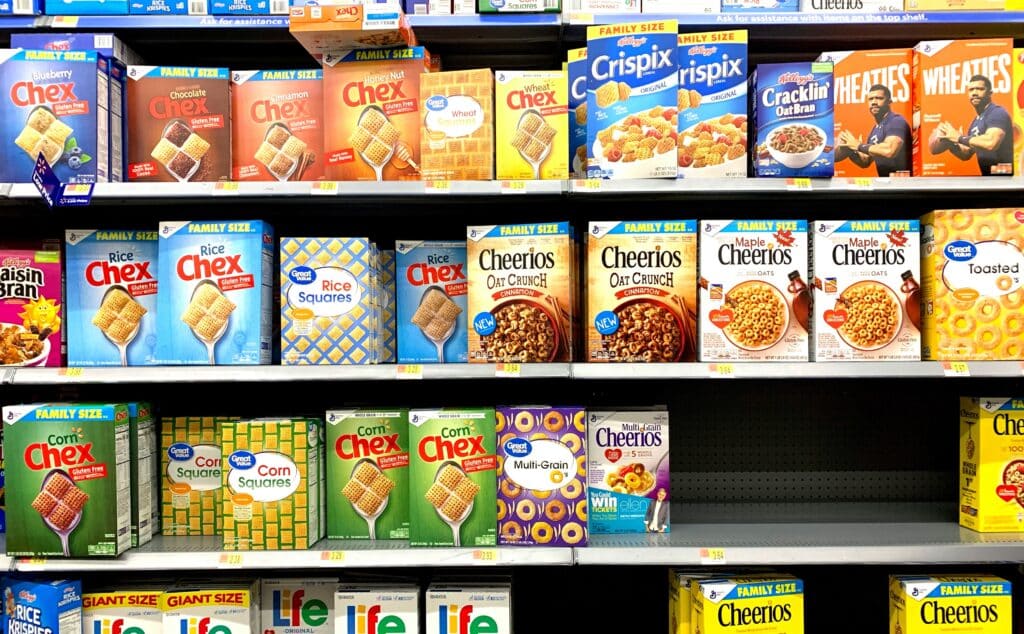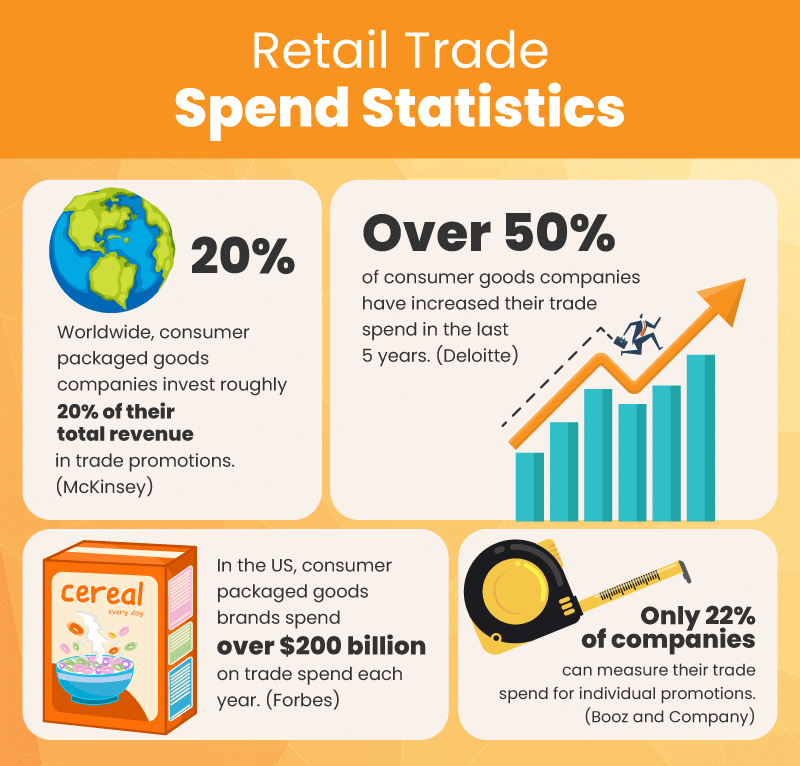
Trade spend plays a pivotal role in the intricate dance between manufacturers and retailers in the retail sector. It encompasses financial activities and strategies aimed at promoting and optimizing product sales.
But what is trade spend in retail? In essence, it’s the monetary investment made by manufacturers to influence retailer behavior, bolster product visibility, and drive consumer purchases. And this investment is significant. In the United States, consumer packaged goods brands spend over $200 billion on trade spend each year.
This article will dissect the nuances of trade spending, shedding light on its strategies, its myriad benefits, and the formidable challenges it presents in the ever-evolving realm of retail.

What is Trade Spend?
Trade spend refers to the money manufacturers or suppliers allocate to support their products’ sales and marketing efforts in the retail sector. Manufacturers invest in enhancing brand recognition, product visibility, and conversion rates.
Trade spending includes various components such as promotional discounts, rebates, marketing campaigns, and cooperative advertising.
Why do Manufacturers Invest in Trade Spend
Trade spending is a strategic maneuver that empowers manufacturers to gain a competitive edge within the retail landscape. Manufacturers can persuade retailers to allocate prime shelf space, run exclusive promotions, or provide preferential treatment by engaging in trade spending activities.
Premium shelf space, for instance, means that prominent merchandising, displays, increasing visibility, and special promotions will drive sales and market share, solidifying their position amid fierce competition.
Consumer Awareness
Investing in trade spend is a strategic imperative for businesses seeking to establish and expand their market presence. It is pivotal in building consumer awareness about a product or brand through various advertising and promotional activities.
These increase visibility and and foster brand recognition, trust, and resonance with the target audience.
Sales Boost
Effective trade spend strategies can significantly boost sales. By optimizing promotional efforts, companies can enhance their bottom line and strengthen brand loyalty and market presence.
These strategies empower businesses to make data-driven decisions, ensuring every marketing dollar is invested wisely, ultimately leading to sustainable growth and profitability.
Strategic Partnerships
Collaborative trade spending efforts foster strong relationships between manufacturers and retailers, which can lead to long-term partnerships and mutual growth. Such alliances often entail open lines of communication and joint planning. This collaboration allows both parties to understand each other’s needs and objectives better.
As a result, manufacturers and retailers can work together more effectively, innovating in product development and marketing strategies. Benefiting from each other’s success helps forge enduring business relationships.
Trade Spending Strategy
There are some common ways that retailers participate in trade spend:
- Promotional Discounts – Manufacturers offer retailers discounts on their products to encourage them to feature these items or run special promotions prominently.
- Rebates – Manufacturers may provide rebates to retailers based on sales performance, incentivizing them to push their products.
- Cooperative Advertising – Manufacturers and retailers jointly fund advertising campaigns to promote products, sharing the costs.
- Merchandising Support – Manufacturers may assist retailers in product merchandising, such as designing in-store displays or providing point of sale materials.
- Slotting Fees – Retailers sometimes charge manufacturers for placing their products on the shelves, especially for prime shelf space.
- Trade Promotions – Temporary price reductions, buy-one-get-one-free deals, or bundled offers are employed to stimulate sales during specific periods.

How Does Trade Spend Benefit Retailers
Retailers benefit from trade spend in several ways:
Promotional Support
Manufacturers often provide financial support to retailers for in-store promotions, such as discounts, unique displays, or advertising campaigns. This support helps retailers attract more customers and boost sales during specific periods.
Inventory Management
Trade spend may also assist retailers in managing their inventory effectively. Manufacturers may offer incentives for retailers to carry more of their products, helping to reduce stockouts and ensure a consistent supply for customers.
Profitability
Retailers can negotiate favorable terms and trade spend agreements with manufacturers, increasing profitability. These agreements may include co-op advertising funds or volume-based discounts directly impacting a retailer’s bottom line.
Relationship Building
Successful trade spend strategies foster strong partnerships between retailers and manufacturers. Working collaboratively and sharing data and insights optimizes marketing efforts and helps retailers adapt to changing consumer preferences, leading to mutual growth and success.
In essence, trade spend is crucial in the retailer-manufacturer ecosystem, helping retailers enhance their competitiveness, profitability, and relationships with suppliers.
Example of Trade Spend In Retail
Let’s take a real-life example involving a popular beer company, XYZ Brewers, and a local convenience store chain, SuperMart, to illustrate how trade spend works:
XYZ Brewers wants to promote its new line of Pale Ales and approaches SuperMart, a well-established retail partner. They engage in negotiations and agree on a trade spend deal. XYZ commits to providing $10,000 in trade spend funds to SuperMart for a one-month promotional campaign.
Promotional Campaign
SuperMart plans a month-long campaign to promote XYZ Beverages’ new line of pale ales. They allocate prime shelf space near the store entrance and create eye-catching displays. Additionally, they run advertisements in their weekly circulars and on their website, all featuring XYZ’s products.
Financial Support
XYZ Brewers disburses the promised $10,000 to SuperMart as part of the agreement. This money is used to cover advertising costs, in-store displays, and any price discounts offered to customers during the promotional period.
Tracking Sales Performance
Throughout the campaign, both parties closely monitor sales data. They track the increase in sales of XYZ’s beers compared to the baseline period before the campaign.
This data helps evaluate the campaign’s effectiveness and measure the return on investment (ROI).
Reaping the Benefits
As a result of the campaign, SuperMart experiences a substantial boost in sales of XYZ’s pale ales. XYZ Beverages also benefits from increased market visibility and consumer awareness. Both parties are satisfied with the results, and their collaboration continues, further strengthening their business relationship.
In this example, trade spend involves financial support from the manufacturer (XYZ Brewers) to the retailer (SuperMart) to execute a promotional campaign. This campaign benefits both parties by driving sales and enhancing brand visibility in the competitive beverage market.
Challenges in Trade Spend Management
Unsurprisingly, retail trade spend comes with some complications. Here are some to think about:
ROI Measurement
Determining the actual return on investment for trade spending activities can be complex due to various factors influencing sales. For example, manufacturers and retailers often have different data systems, making collecting and analyzing ROI data effectively challenging.
Promotion Clutter and Cannibalization
Excessive promotions in a highly competitive market can lead to customer confusion and margin erosion. Also, promotions intended to boost sales might cannibalize the sales of other products, affecting overall profitability.
Compliance Issues
Compliance issues can pose a significant challenge in retail trade spend because they demand rigorous adherence to agreed-upon promotional activities and financial commitments. Retailers may need help consistently executing planned trade spend activities, potentially causing friction with manufacturers and jeopardizing long-term partnerships.
Full compliance can be particularly challenging in dynamic retail environments where market conditions and consumer preferences frequently change, requiring constant adjustments to trade spend strategies.
KORONA POS has exceeded my expectations in every way. It’s a powerful, adaptable solution that has transformed our operations for the better.
-James B.
Conclusion
Trade spend is a crucial aspect of many retail operations. It serves as a bridge between manufacturers and retailers to enhance product visibility, drive sales, and build lasting partnerships.
Understanding the strategies, benefits, and challenges associated with trade spend is essential for retailers to maximize their potential and achieve sustainable growth in the dynamic world of retail. The best way to measure your growth and ROI is with robust inventory management and analytics.
KORONA POS offers the most comprehensive inventory platform in the industry. Our sales reporting and analytics help illuminate all aspects of running a retail shop.
Take your business to the next level. Click the link below to speak with an in-house technician!
FAQs: What is Trade Spend in Retail
An example of trade spend is a shampoo manufacturer offering a pharmacy chain a financial incentive of $10,000 to prominently display their new line of products in-store for a month. This could involve placing the products at the store entrance and creating eye-catching displays. The manufacturer’s investment aims to boost sales and increase brand visibility. The retailer benefits from the financial support and increased foot traffic generated by the promotion.
Trade spend is typically calculated by aggregating all the financial incentives and resources that a manufacturer allocates to support their products’ sales and marketing efforts within a specific retail period. This includes expenses related to promotional discounts, rebates, marketing campaigns, cooperative advertising, etc. The total trade spend amount is then measured against the increase in sales, market share, or other performance metrics to evaluate its effectiveness and return on investment (ROI).
The percentage of revenue allocated to trade spend can vary significantly across industries and companies. In some industries with intense competition and slim profit margins, like consumer packaged goods, trade spend might represent a substantial portion of revenue, ranging from 10% to 20% or even higher. However, trade spend may be considerably lower in industries with higher margins or specialized products, like technology, typically around 5% to 10%.













